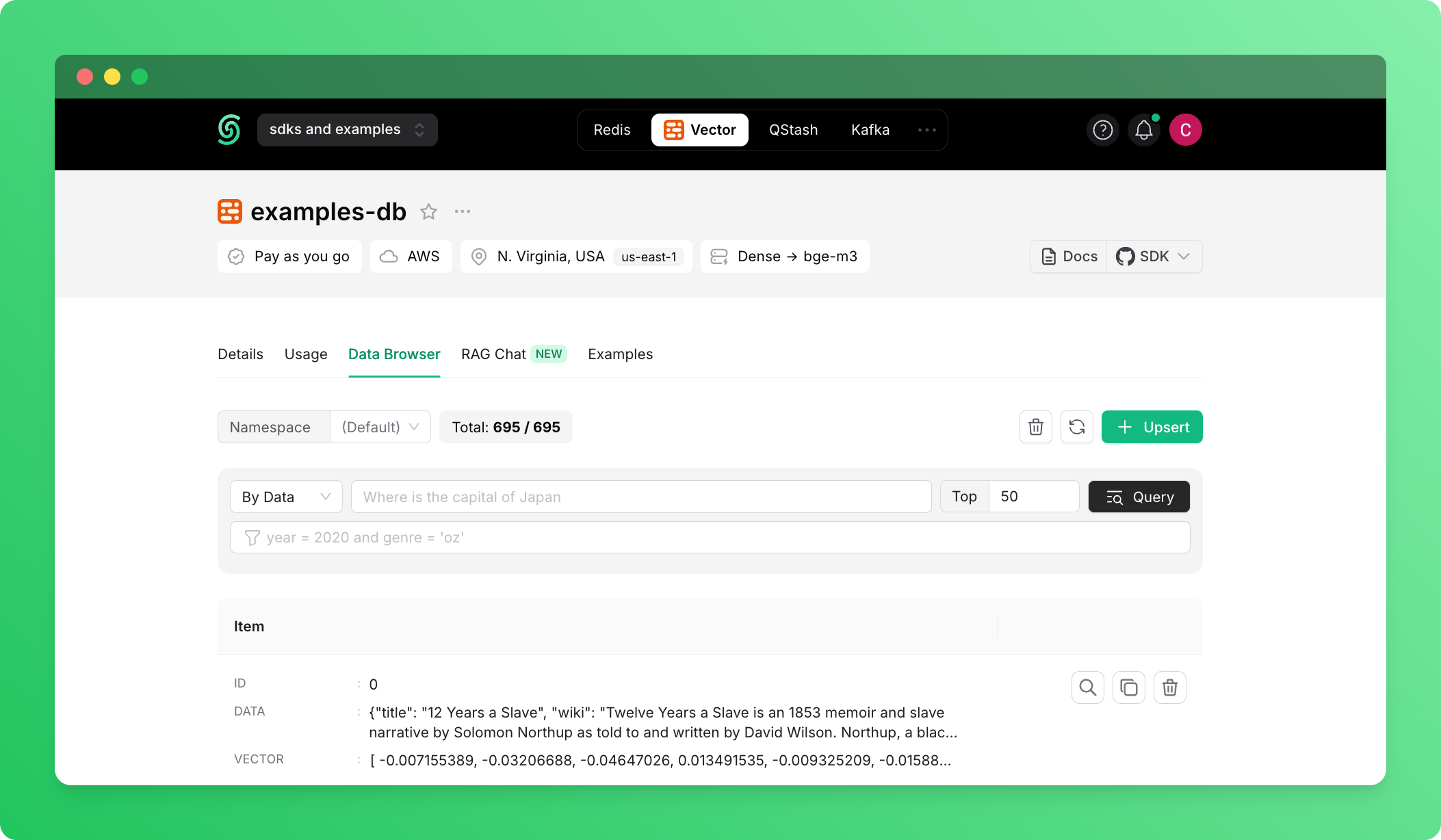PrerequisiteYou need an Upstash account before creating a vector, create one
here. Create an Index
Once you logged in, you can create a Vector Index by clicking on the Create Index button in the Vector tab.
Name: Type a name for your index.
Region: Choose the region for your index. For optimal performance, select the region closest to your applications. We plan to support additional regions and cloud providers. Feel free to send your requests to [email protected]
Type: The type of index: Dense, Sparse or Hybrid. For semantic search, you can prefer dense. For full text (or keyword) search, you can prefer sparse. If you need a combination, you can choose hybrid.
If you choose Dense or Hybrid as index type, you will also be presented with options to select the dimensions and distance metric of your index.
For the purpose of using the code samples on this page, you can create a dense index with dimension: 2. Distance metric can be any of the options.
Insert Index
You can access data in your index using REST API or our SDKs. You can copy the sample code from the Connect section in the console.
Python
JavaScript
Go
PHP
curl
from upstash_vector import Index
index = Index(url="UPSTASH_VECTOR_REST_URL", token="UPSTASH_VECTOR_REST_TOKEN")
index.upsert(
vectors=[
("1", [0.6, 0.8], {"field": "value"}),
]
)
import { Index } from "@upstash/vector";
const index = new Index({
url: "UPSTASH_VECTOR_REST_URL",
token: "UPSTASH_VECTOR_REST_TOKEN",
})
await index.upsert({ id: "1", vector: [0.6, 0.8], metadata: {field: "value"} })
import "github.com/upstash/vector-go"
func main() {
index := vector.NewIndex("UPSTASH_VECTOR_REST_URL", "UPSTASH_VECTOR_REST_TOKEN")
index.Upsert(vector.Upsert{
Id: "1",
Vector: []float32{0.6, 0.8},
Metadata: map[string]any{"field": "value"},
})
}
use Upstash\Vector\Index;
use Upstash\Vector\VectorUpsert;
$index = new Index(
url: 'UPSTASH_VECTOR_REST_URL',
token: 'UPSTASH_VECTOR_REST_TOKEN',
);
$index->upsert(new VectorUpsert(
id: '1',
vector: [0.6, 0.8],
metadata: ['field' => 'value'],
));
curl $UPSTASH_VECTOR_REST_URL/upsert \
-X POST \
-H "Authorization: Bearer $UPSTASH_VECTOR_REST_TOKEN" \
-d '{"id": "1", "vector": [0.6, 0.8], "metadata": {"field": "value"}}'
Query Index
You can perform a similarity search by providing a query vector as a parameter. The dimension of the query vector must match the dimension of your index. Also, you can query by metadata filtering.
Upstash is eventually consistent, so there may be a delay before the newly inserted or updated vectors are ready for querying.
Python
JavaScript
Go
PHP
curl
from upstash_vector import Index
index = Index(url="UPSTASH_VECTOR_REST_URL", token="UPSTASH_VECTOR_REST_TOKEN")
index.query(
vector=[0.6, 0.8],
top_k=3,
include_metadata=True,
)
import { Index } from "@upstash/vector";
const index = new Index({
url: "UPSTASH_VECTOR_REST_URL",
token: "UPSTASH_VECTOR_REST_TOKEN",
})
await index.query({ vector: [0.6, 0.8], topK: 3, includeMetadata: true })
import "github.com/upstash/vector-go"
func main() {
index := vector.NewIndex("UPSTASH_VECTOR_REST_URL", "UPSTASH_VECTOR_REST_TOKEN")
index.Query(vector.Query{
Vector: []float32{0.6, 0.8},
TopK: 3,
IncludeMetadata: true,
})
}
use Upstash\Vector\Index;
use Upstash\Vector\VectorQuery;
$index = new Index(
url: '<UPSTASH_VECTOR_REST_URL>',
token: '<UPSTASH_VECTOR_REST_TOKEN>',
);
$index->query(new VectorQuery(
vector: [0.6, 0.8],
topK: 3,
includeMetadata: true,
));
curl $UPSTASH_VECTOR_REST_URL/query \
-H "Authorization: Bearer $UPSTASH_VECTOR_REST_TOKEN" \
-d '{"vector": [0.6, 0.8], "topK": 3, "includeMetadata": "true"}'
Usage and Data Browser
In Upstash console, you can see the charts of your index:
There are following charts:
- Daily Requests: The number of queries and updates to your index in the last 5 days.
- Throughput: The number of queries and updates to your index in the selected time period.
- Latency: The mean and P99 latency of queries and updates to your index in the selected time period.
- Vector Count: The number of vectors in your index in the selected time period.
- Data Size: The size of your index in the selected time period.
You can also query your index with a simple UI:






